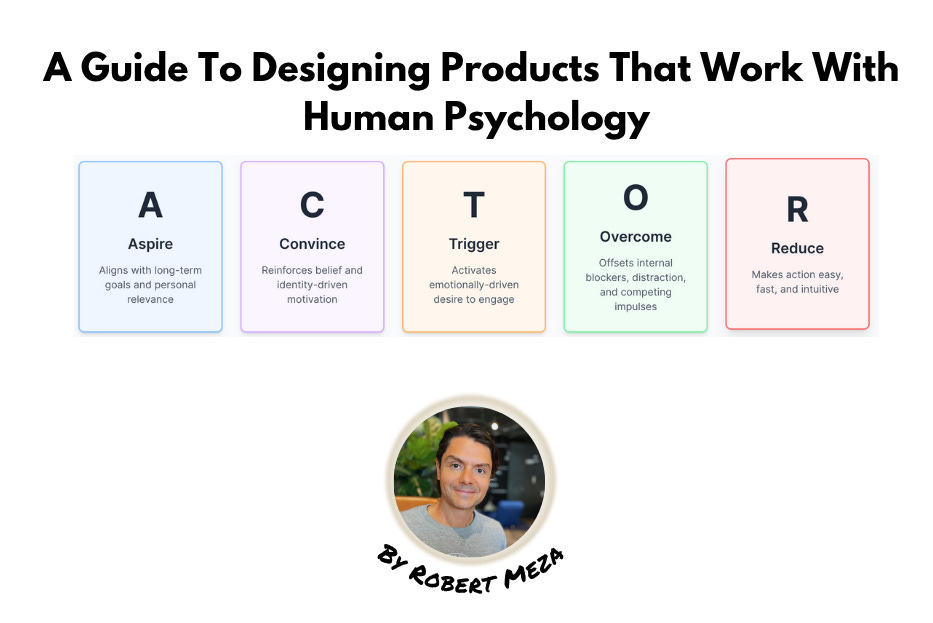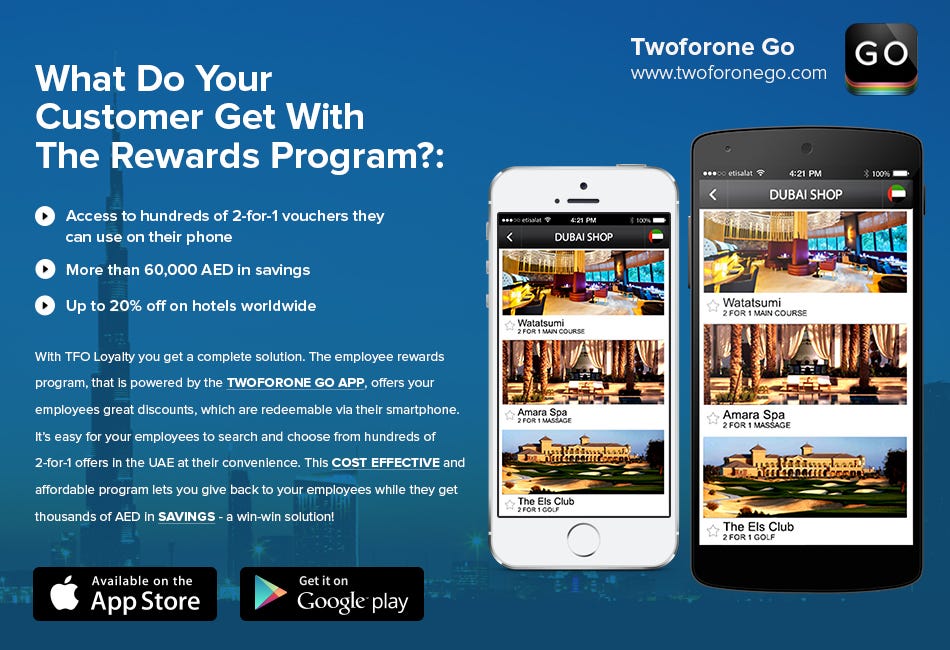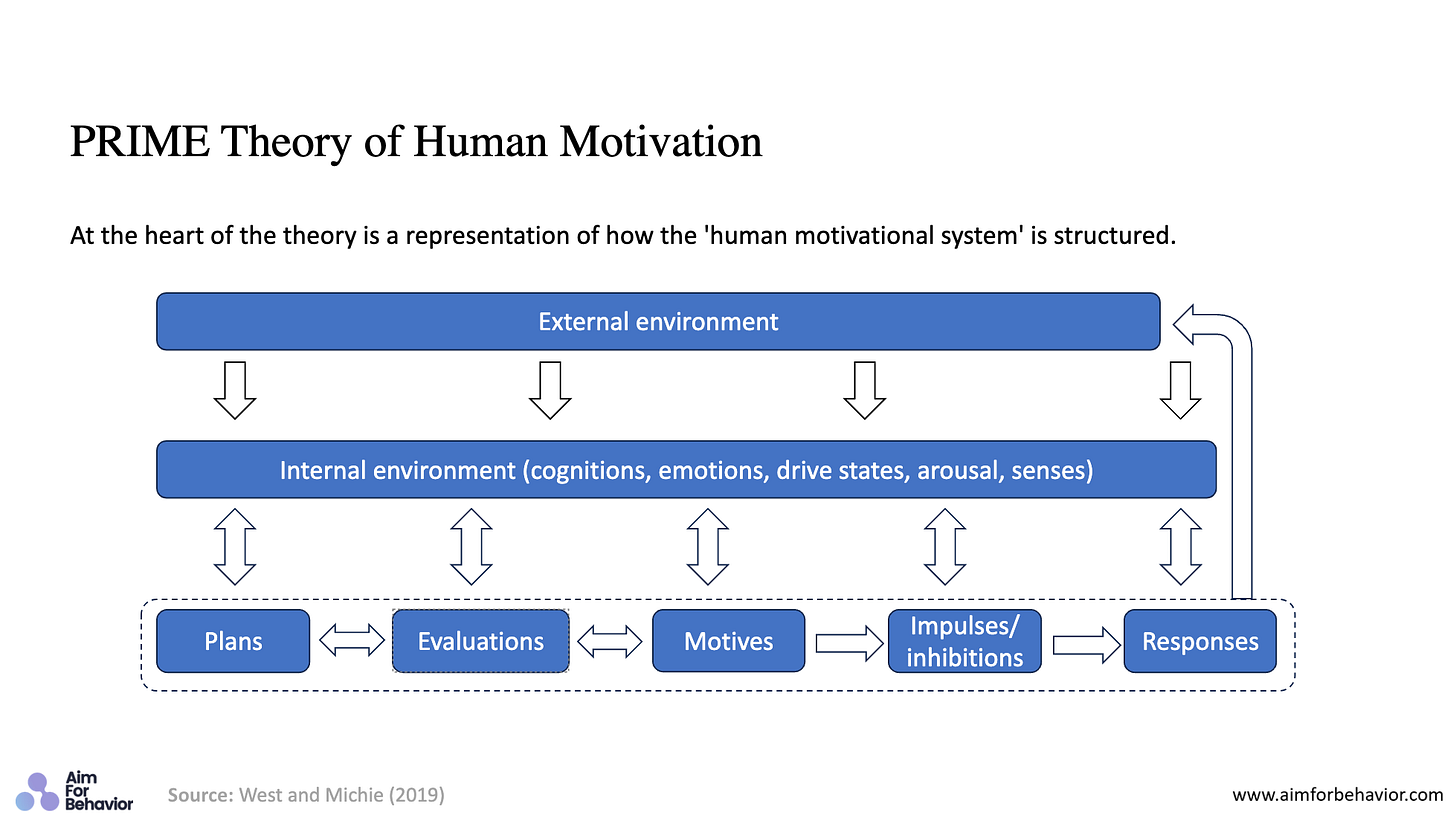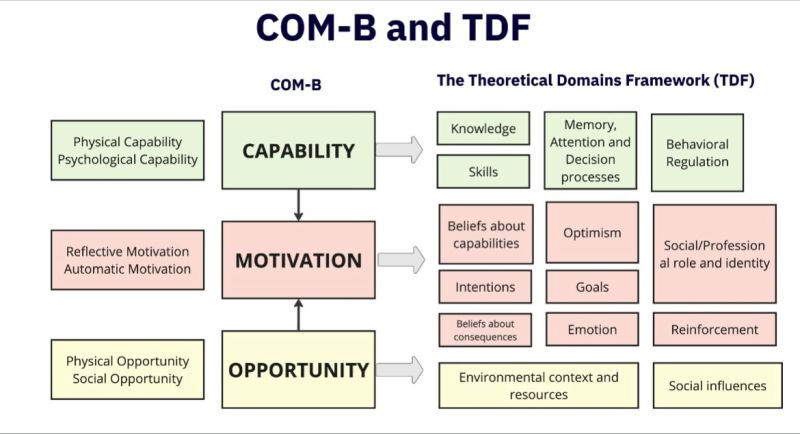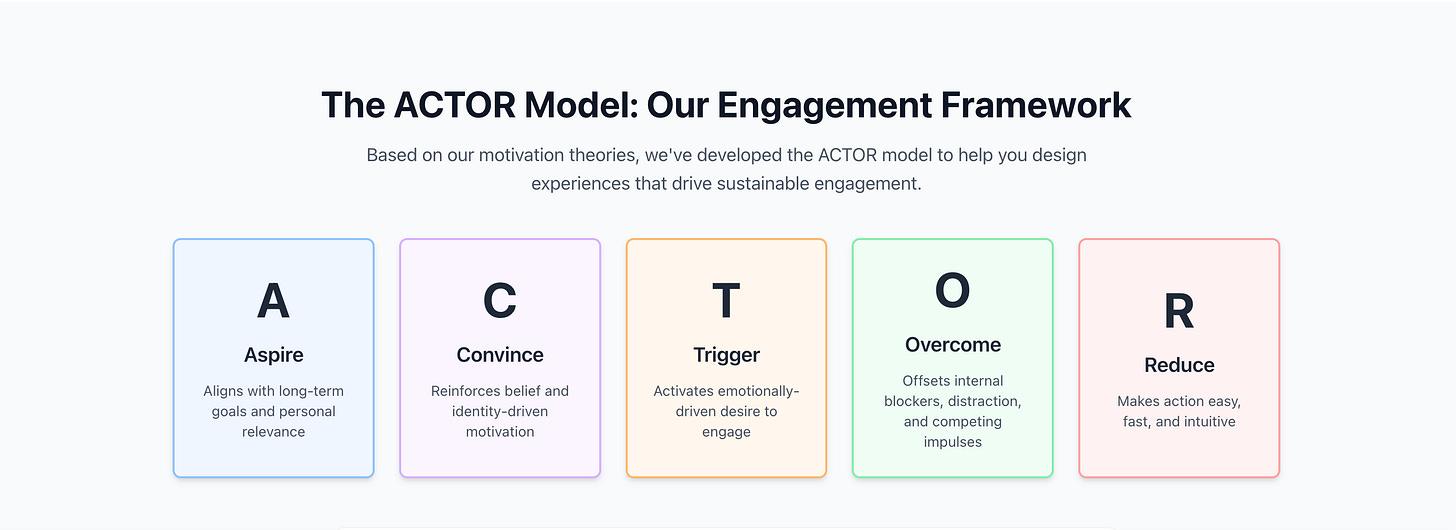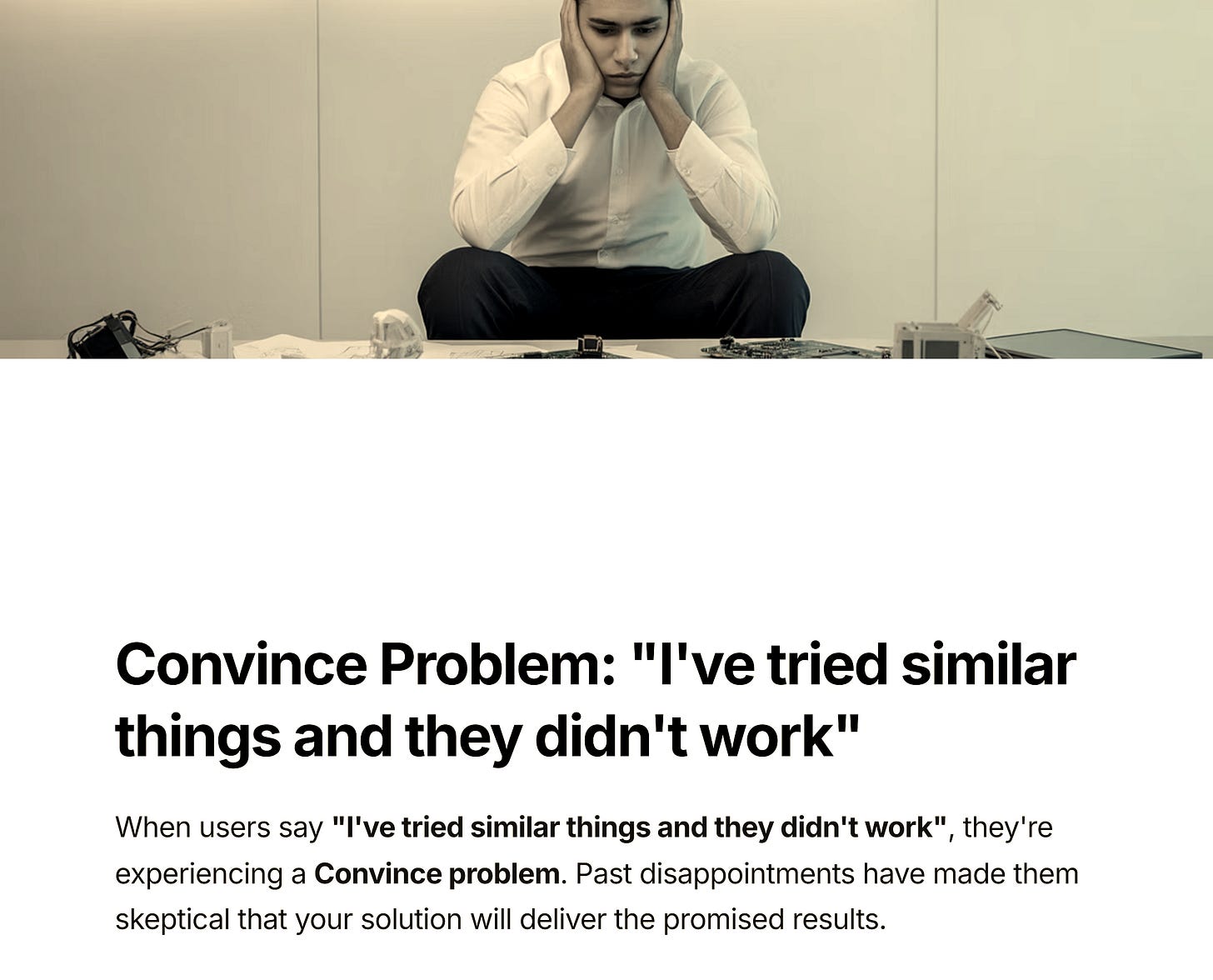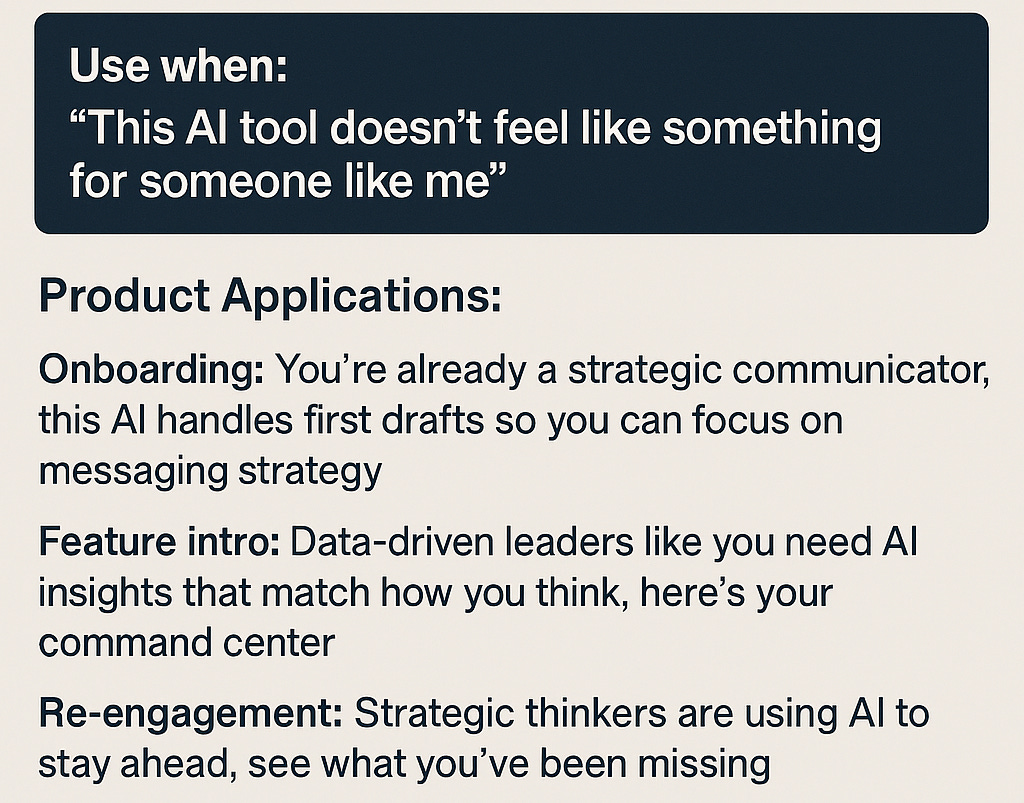Why Users Abandon Your Products (And How to Fix It)
The ACTOR Model for Product Teams
Frustrated with the frameworks and tools that were out there for designing and developing digital products focused on behavior change, I decided to create a model called ACTOR - one that I will be sharing with you in this guide.
ACTOR explains why smart users abandon products they love (it's psychological, not logical) and gives you the exact process to design for how motivation actually works instead of how you think it should work.
I created the model after years of working on digital products and services. I started working on my first app back in 2011 (a few years after the app store had opened). It was a rewards app.
When I started working on it, I thought the product made logical sense. The onboarding was easy, I was obsessed with the experience (apologies to all the designers and engineers I kept pushing relentlessly - from the agency building it for us - to ruthlessly fixing every single detail).
It was an exciting ride, in the end we even managed to get the app to #1 in the app store, just to see users abandon it.
Nearly 14 years later, organizations are still facing product issues like:
Downloads growing for AI tools, but daily active users start falling after a few weeks
Teams getting excited about new software but reverting to old tools under pressure
Customers understanding a digital health app's value but not changing their behavior
I believe the issue isn't your product. It's that you’ve been told to design for how we think people should behave, not for how they actually make decisions.
How Motivation Actually Works
If you have been working on behavior change, you may have heard of PRIME Theory, though I suspect most people have not used it. I became a bigger fan of it because Maria Arbiter from my team had been using it for a while in digital health and because we have done projects together applying it.
For the rest of you who have not heard about it, it basically shows that every user action emerges from five psychological components interacting in real-time: (this is not an academic insights hub, so I won’t go into all the details on PRIME).
Those 5 components are:
Plans: Consciously articulated specific plans to carry out behaviors ("I'll use this AI tool to be more productive")
Responses: Hardwired or physiological tendencies shaping behavior at an unconscious level ("Reverted to manual process under pressure")
Impulses: The forces driving behavior - emotions, habits, human drives ("Just use the familiar tool for now")
Motives: What does the person want and need to do ("Need to deliver this quickly")
Evaluations: Evaluations are beliefs about whether one should do the behavior. ("This AI tool is probably helpful")
The key insight
At any given moment we have lots of different drives that can override motivation.
We can use PRIME theory to help us design something that is tailored to this:
✓ Reducing distraction
✓ Making the behavior rewarding
✓ Building in ways to make the behavior very easy for when someone is tired, hungry, distracted.
Why Not Just COM-B?
You can use COM-B (also by Michie and colleagues) to do your diagnosis and then layer on PRIME Theory when you are specifically targeting a motivation. Both tools are very useful for their specific uses, but I still needed something for designing against motivational failure in practice.
That is where the ACTOR model appeared. It strengthens the downstream motivational support structures that PRIME and COM-B identify, without assuming control over core motivational impulses. A tool for testing and optimizing motivational system design, not just UI or generic copy changes.
PRIME is your theory. COM-B is your diagnosis. ACTOR is your method.
ACTOR: A Better Way for Motivation Design
ACTOR is meant to be applied when you've addressed structural barriers - i.e, users have skills, access, organizational support etc. and not instead of it or before it.
The Acronym stand for:
Aspire: Aligns with long-term goals and personal relevance
Convince: Reinforces belief and identity-driven motivation
Trigger: Activates emotionally-driven desire to engage
Overcome: Offsets internal blockers, distraction, and competing impulses
Reduce: Makes action easy, fast, and intuitive
ACTOR is meant for people working daily to get results in their organizations and who need a better approach to design for motivation. (While there are other theories that make up ACTOR, I won’t refer to them here)
Below you will find a LITE version of how you could apply ACTOR in your work.
ACTOR - Implementation Guide (LITE)
Step 1: Diagnose Your Motivational Challenge
Map Competing Alternatives
List 3-5 alternatives your users choose instead of your product:
Identify Your Dominant Failure Pattern
Rate each area (1-10) to find your weakest point:
Identity Alignment (Aspire)
“Does this feel like something someone like me would use?”Credibility Strength (Convince)
“Do I believe this will work for me, in my context?”Emotional Activation (Trigger)
“Is there a compelling reason to engage now instead of later?”Competing Priorities (Overcome)
“What consistently beats this when I could be using it?”Execution Friction (Reduce)
“How many steps, decisions, or hurdles are in the way?”
Your primary focus: The lowest-scoring areas become your priority.
Red Flag Phrases That Signal ACTOR Issues
"This isn't really for someone like me" → Aspire problem
"I've tried similar things and they didn't work" → Convince problem
"I know I should use it but never think about it" → Trigger problem
"I start to use it but other things come up" → Overcome problem
"It's too complicated/takes too long" → Reduce problem
Step 2: Implementation Protocol Lite
Component Integration Strategy
For each failure pattern, combine 2 ACTOR components:
Identity misalignment: Aspire + Convince (identity connection + peer proof)
Credibility gaps: Convince + Reduce (rebuild trust + effortless trial)
Motivational dormancy: Trigger + Aspire (emotional activation + identity reinforcement)
Competing priorities: Overcome + Reduce (address barriers + eliminate friction)
Execution friction: Reduce + Trigger (simplify experience + optimal timing)
Step 3: Use ACTOR Component Examples To Guide Your Solutions
Aspire - Identity Connection
Use when: "This AI tool doesn't feel like something for someone like me"
Product Applications:
Onboarding: "You're already a strategic communicator, this AI handles first drafts so you can focus on messaging strategy"
Feature intro: "Data-driven leaders like you need AI insights that match how you think, here's your command center"
Re-engagement: "Strategic thinkers are using AI to stay ahead, see what you've been missing"
Note: Identity framing should match your users' actual self-perception. Test different identity anchors (technical expert, efficiency-focused, innovation leader) to find what resonates.
Convince - Credibility Building
Use when: "I've tried similar apps before and they didn't work"
Product Applications:
Social proof: "Engineering teams similar to yours find 8 out of 10 AI code suggestions save meaningful development time"
Feature validation: "See how development teams with your challenges cut deployment time in half using our automated testing suite"
Onboarding: "Product teams at companies like yours report 40% faster feature validation using our AI-powered research platform"
Trigger - Emotional Activation
Use when: "I know this software is useful but never think about it"
Product Applications:
Smart notifications: "Your sprint is behind schedule, see which features could get you back on track in the next 2 hours"
Contextual prompts: "Your AI just caught a pattern that could save your team 3 hours of debugging, want to see it?"
In-app triggers: "Feeling the code review bottleneck again? Here's the 2-minute solution that just worked for another team"
Overcome - Resistance Management
Use when: "I start to use the new tool but always go back to the old one under pressure"
Product Applications:
Impulse interruption: "About to switch back to manual? This automated check takes 30 seconds vs. the 20 minutes you're about to spend"
Competing urge acknowledgment: "When deadlines hit, familiar feels safer, but this tool is designed for exactly these pressure moments"
Recovery from lapses: "Went back to the old workflow? No problem, here's what changed while you were away, pick up in 1 click"
Reduce - Friction Elimination
Use when: "This platform is too complicated/takes too long to use"
Product Applications:
Smart onboarding: "Connect your GitHub repo, our AI will analyze your codebase and set up monitoring automatically"
Automated setup: "Connect your project management tool, we'll map your workflows and suggest optimizations"
Simplified activation: "Here's what development teams like yours find most useful, one click to activate AI insights"
I included some digital examples and even prototyped some with an AI tool in my Behavior Change Course
Step 4: Testing and Integration Lite
Testing Framework
ACTOR Lite Testing (for quick validation):
Choose your primary failure pattern
Design intervention for 2 ACTOR components
A/B test
Measure: activation rate, feature adoption, weekly retention
Iterate based on which psychological approach drives behavior
Integration with Product Development
Product Managers:
Add ACTOR assessment to feature planning: "Which PRIME component is most likely to fail?"
UX Designers:
Annotate wireframes with ACTOR components
Test motivational resonance of copy, not just usability
Design for psychological states alongside task flows
Engineers:
Choose defaults that align with user identity (Aspire)
Design error states as recovery paths (Overcome)
Consider behavioral impact of technical decisions
Step 5: Measurement and Optimization
Behavioral Metrics
Track the full engagement cycle:
Activation: % who take first meaningful action after onboarding
Depth: Do they use core features or just peripheral ones?
Frequency: Weekly active usage patterns
Recovery: Return rate after dropping off
Advocacy: Willingness to recommend to similar users
Motivational Diagnostics
Monitor psychological indicators:
Identity alignment: "This feels like something someone like me would naturally use" (1-7 scale)
Credibility perception: "I believe this will actually work in my situation" (1-7 scale)
Emotional engagement: Usage during high-stress vs. low-stress periods
Friction perception: Time-to-value and abandonment points
Optimization Protocol
Analyze user behavior patterns and identify drop-off points
Implement targeted ACTOR improvements based on data
Measure impact and plan scaling strategy
Step 6: Scale and Systematize
Ongoing
Build your components library, your systems etc.. so you know what has worked and what it’s addressing and keep going.
Quick Implementation Checklist
Week 1: Diagnosis
[ ] List 3-5 competing alternatives users choose instead
[ ] Rate your product on 5 ACTOR components (1-10 scale)
[ ] Identify lowest-scoring area as primary intervention focus
Week 2: Design
[ ] Create targeted messaging for 2 ACTOR components
[ ] Design A/B test comparing psychological approaches
[ ] Set up measurement for behavioral outcomes
Week 3-4: Test and Iterate
[ ] Launch test
[ ] Monitor activation, engagement, and retention metrics
[ ] Refine intervention based on what actually drives behavior
Week 5-8: Optimize and Scale
[ ] Analyze user patterns and psychological indicators
[ ] Implement improvements across full user base
[ ] Build systematic capability for ongoing optimization
Your Next Steps
Choose one user behavior critical to your product's success
Complete the ACTOR diagnostic to identify your primary motivation friction type
Design targeted solutions focusing on 2 ACTOR components
Test with a small user group and measure behavioral outcomes
Scale successful approaches systematically across your user base
The products that consistently drive user behavior aren't just well-designed, they're psychologically intelligent.
What user behavior will you redesign first?
In closing, I want to re-iterate that the organizations that consistently drive behavior change aren't hoping their products work, they're systematically and holistically designing for behavior.
ACTOR provides one tool for diagnosing exactly why users abandon great products and designing interventions that work with psychological reality and when the focus in motivation
Robert Meza develops systematic approaches to human behavior change for technology companies, healthcare systems, and government agencies and is the founder of Aim For Behavior



